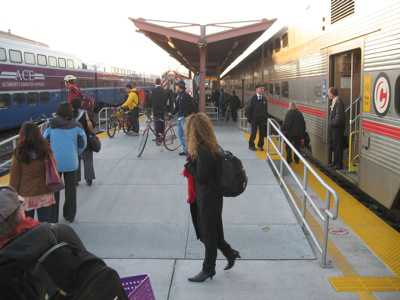No Light Rail in Vancouver!
Light Rail Follies #2: 20th Anniversary

The nation’s worst-
Thanks to the high cost of light rail and the foolish decisions of the Valley Transportation Authority’s, the article notes, VTA is forced to cut bus service again this January. VTA is actually considering spending $334 million extending one of its lines in a project that is projected to attract less than 2,200 riders a day.

The average U.S. light-
Flickr photo by skew-
Today’s situation “is a long way from transit heaven,” the article admits, pointing out that — thanks to previous service cuts — bus ridership dropped by more than a third in the early 2000s and hasn’t come close to recovering since.
Still, VTA has its true believers, including the head of the Silicon Valley Leadership
Group, who claims that San Jose light rail carries “more people than ride CalTrain,”
the San Jose-

CalTrain, on the right, carries more people at a smaller cost to taxpayers than VTA’s light rail. The Altamont Commuter Express, left, doesn’t do as well, but still costs less per passenger mile than light rail.
Flickr photo by Richard Masoner.
The Merc-
The newspaper faithfully parrots the line that light rail “helped spur development and lure people downtown” — but notes that the hundreds of millions of dollars of redevelopment (TIF) money might have played a role. “No one thinks light rail hasn’t helped,” says the writer, who obviously failed to consult the Antiplanner.
“The light-
The article quotes the Antiplanner’s friend, Tom Rubin — or misquotes him, anyway, saying that he said the transit agency’s approach has been to offer anyone a ride from any place at the lowest fare possible. Actually, VTA’s general manager was the one who said this.
What Rubin actually said was that Silicon Valley, with its jobs spread out more thinly
than almost anywhere else in the country, was unsuited for large-
Light rail was the wrong solution for San Jose in 1987, it is the wrong solution
today, and it still will be the wrong solution in 2027. We can only hope that San
Jose’s leaders and opinion makers, including the Mercury-
Trackback • Posted in Transportation
12
Reprinted from The Antiplanner